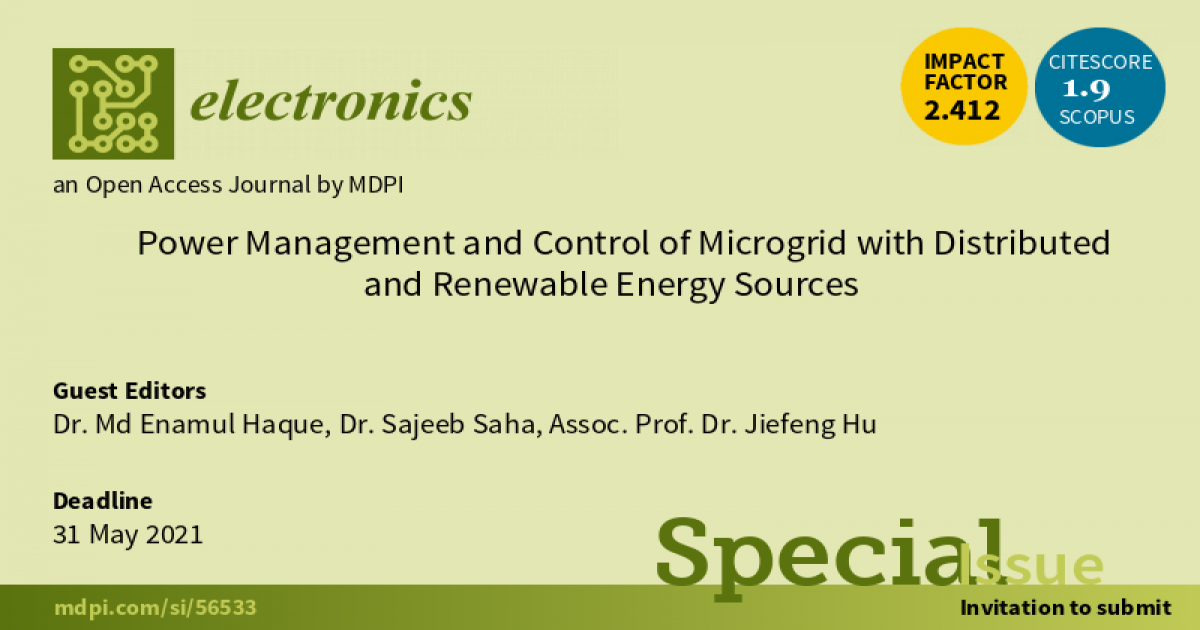Power Management and Control of Microgrid with Distributed and Renewable Energy Sources
A special issue of Electronics (ISSN 2079-9292). This special issue belongs to the section "Power Electronics".
Deadline for manuscript submissions: closed (31 May 2021) | Viewed by 7219

Special Issue Editors
Interests: control of power electronic converters for renewable energy (wind, solar PV, FUEL CELL) SYSTEMS; MICROGRID; BATTERY/SUPERCAPACITOR ENERGY STORAGE SYSTEM; MOTOR DRIVE FOR ELECTRIC VEHICLE (EV) and EV system technologies; cyber security in power electronics system/microgrid/smartgrid
Special Issues, Collections and Topics in MDPI journals
Interests: power system dynamic modelling; control; fault detection; microgrid control; cyber security of power grid
Special Issues, Collections and Topics in MDPI journals
Interests: sustainable energy systems & power electronics (wind turbine systems, solar photovoltaic (PV) systems, grid integration of renewable energy sources); microgrids & smart grid technologies; electric drives & electric vehicle technologies
Special Issues, Collections and Topics in MDPI journals
Special Issue Information
Dear Colleagues,
Microgrid can play a significant role in managing and controlling distributed and renewable-based generators and overcoming associated grid integration challenges. Different microgrid structures such as DC microgrid, AC microgrid, hybrid AC/DC microgrid, and control techniques will be implemented for smooth and reliable operation of microgrid, and new developments are required to solve several issues and challenges mainly related to design, control, power management, protection, stability, power quality and harmonics, and cyber security. The purpose of this Special Issue is to address and disseminate state-of-the-art research in microgrids by academics, industries, and research organizations. This Special Issue will bring together recent advances in microgrid and will offer a major forum for reporting advances in microgrid research and associated technologies to uptake renewable-based generation. Topics of interest include but are not limited to the following:
- Recent advancement in microgrids and emerging microgrid technologies;
- Microgrid structures and configurations, Design of microgrid;
- Power electronic converters for microgrid:
- DC to DC, AC–DC, and DC–AC converter topologies;
- Bidirectional converter topologies for energy storage integration;
- Multilevel converter;
- Grid-forming smart inverter;
- Advanced control and energy management of DC, AC, hybrid AC/DC microgrids:
- Model predictive control of microgrid;
- Advanced control of wind energy system, solar PV, and energy storage system;
- Advanced control techniques for seamless transition from off-grid to on-grid modes of operation;
- Distributed/decentralized secondary control for voltage and frequency restoration;
- Energy management algorithm for microgrids;
- Microgrid integration and their impact on the distribution grid:
- Voltage regulation, system inertia and frequency regulation, distribution grid stability;
- Power quality and harmonics;
- Islanding detection and synchronization of microgrid;
- Microgrid protection;
- Energy storage for microgrid:
- Battery energy storage;
- Supercapacitor energy storage;
- Energy storage for ancillary services;
- Integration of electric vehicles in microgrids and vehicle-to- grid (V2G) and grid-to-vehicle (G2V) operation;
- Cyber security of microgrid.
Dr. Md Enamul Haque
Dr. Sajeeb Saha
Assoc. Prof. Dr. Jiefeng Hu
Guest Editors
Manuscript Submission Information
Manuscripts should be submitted online at www.mdpi.com by registering and logging in to this website. Once you are registered, click here to go to the submission form. Manuscripts can be submitted until the deadline. All submissions that pass pre-check are peer-reviewed. Accepted papers will be published continuously in the journal (as soon as accepted) and will be listed together on the special issue website. Research articles, review articles as well as short communications are invited. For planned papers, a title and short abstract (about 100 words) can be sent to the Editorial Office for announcement on this website.
Submitted manuscripts should not have been published previously, nor be under consideration for publication elsewhere (except conference proceedings papers). All manuscripts are thoroughly refereed through a single-blind peer-review process. A guide for authors and other relevant information for submission of manuscripts is available on the Instructions for Authors page. Electronics is an international peer-reviewed open access semimonthly journal published by MDPI.
Please visit the Instructions for Authors page before submitting a manuscript. The Article Processing Charge (APC) for publication in this open access journal is 2400 CHF (Swiss Francs). Submitted papers should be well formatted and use good English. Authors may use MDPI's English editing service prior to publication or during author revisions.
Benefits of Publishing in a Special Issue
- Ease of navigation: Grouping papers by topic helps scholars navigate broad scope journals more efficiently.
- Greater discoverability: Special Issues support the reach and impact of scientific research. Articles in Special Issues are more discoverable and cited more frequently.
- Expansion of research network: Special Issues facilitate connections among authors, fostering scientific collaborations.
- External promotion: Articles in Special Issues are often promoted through the journal's social media, increasing their visibility.
- e-Book format: Special Issues with more than 10 articles can be published as dedicated e-books, ensuring wide and rapid dissemination.
Further information on MDPI's Special Issue polices can be found here.







